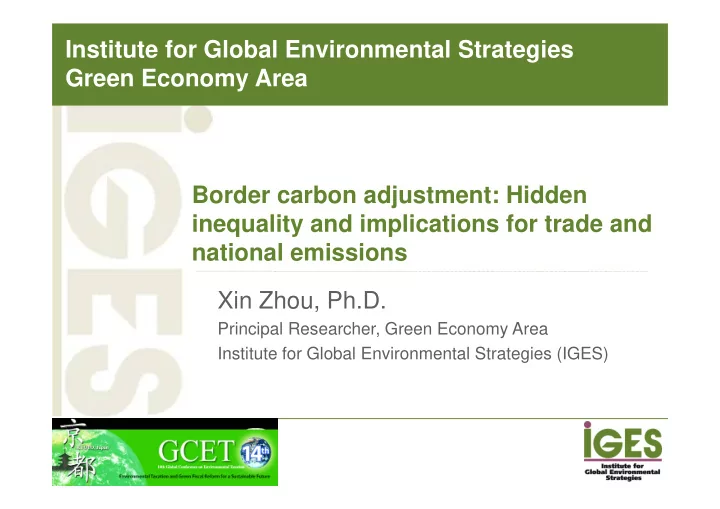

Institute for Global Environmental Strategies Green Economy Area Border carbon adjustment: Hidden inequality and implications for trade and national emissions Xin Zhou, Ph.D. Principal Researcher, Green Economy Area Institute for Global Environmental Strategies (IGES)
IGES Green Economy Area Border carbon adjustment: Implications for trade and national emissions Introduction Kyoto Protocol and asymmetric domestic climate policies; Carbon pricing policy in developed countries (carbon tax or emissions trading system) and the impacts on domestic production costs and on the terms of trade; Role of business for enabling sustainable lifestyles Two concerns: industrial competitiveness and carbon leakage (production channel, investment channel and energy channel); Energy intensive and trade exposed (EITE) sectors: ferrous metals (iron and steel), non metallic mineral products (in particular cement), non-ferrous metals (in particular aluminium), pulp and paper, and chemicals. Xin Zhou IGES http://www.iges.or.jp 2
IGES Green Economy Area Border carbon adjustment: Implications for trade and national emissions Introduction Border carbon adjustment (BCA): border tax adjustment (import tariffs and export rebate, etc.) Carbon costs Role of business for enabling sustainable lifestyles Terms of trade before border adjustment Production costs Production costs of domestic of imported goods goods Country A Country B (with policy) (without policy) Carbon costs due Carbon costs due to climate policy to border adjust Terms of trade after Production costs Production costs border adjustment of domestic of imported goods goods Country A Country B (with policy) (without policy) Xin Zhou IGES http://www.iges.or.jp 3
IGES Green Economy Area Border carbon adjustment: Implications for trade and national emissions Inequality issue Current national inventory approach of the Kyoto Protocol requires countries to report “emissions and removals taking place within national territories…” (UNFCCC, 1998). Emissions related to exports are reported in the national Role of business for enabling sustainable lifestyles inventory of the exporting countries. Pay for the Receive the 10 Kt- carbon costs right to emit CO 2 Xin Zhou IGES http://www.iges.or.jp 4
IGES Green Economy Area Border carbon adjustment: Implications for trade and national emissions Proposal for exemption Country B with a compatible climate policy in place should be exempted from the BCA of Country A Role of business for enabling sustainable lifestyles Xin Zhou IGES http://www.iges.or.jp 5
IGES Green Economy Area Border carbon adjustment: Implications for trade and national emissions Proposal for NIAfT National inventory adjustment for trade (NIAfT) for Country B without a compatible climate policy but paying the carbon costs at the border (similar to receiving the emissions credits). Role of business for enabling sustainable lifestyles Xin Zhou IGES http://www.iges.or.jp 6
IGES Green Economy Area Border carbon adjustment: Implications for trade and national emissions Implications for trade and emissions GTAPinGAMS, a multi-region computable general equilibrium (CGE) model, to assess the impacts of carbon tax policy in Japan, the introduction of BCA and the NIAfT. Carbon tax implemented in Japan can reduce domestic Role of business for enabling sustainable lifestyles emissions and at the same time trigger the carbon leakage mechanism. However both effects are very small. BCA can be an effective measure to address the emissions out of the border and therefore effective to address carbon leakage; However when NIAfT is introduced, there is a strong negative carbon leakage, i.e. great increase in domestic emissions and great decrease in other countries out of the border. Xin Zhou IGES http://www.iges.or.jp 7
IGES Green Economy Area Border carbon adjustment: Implications for trade and national emissions Implications for trade and emissions • Compatibility issue: If B implements a domestic climate policy which is considered incomparable with the one implemented in A. Given other conditions equal, the carbon costs of the same products produced in B will then be less than the carbon costs in A, P A >P B . Even though both countries implement domestic climate policies, the competitiveness and carbon leakage concerns still remain unsolved under this situation. How to define Role of business for enabling sustainable lifestyles the comparability of domestic climate policies among participation countries is also a practical issue in designing a BCA and discussed by many BCA proposals. • Direct vs. indirect carbon emissions There are two broad ways. One is to use direct emissions from production of the products and the other is to use both direct and indirect emissions associated with production of the products. In the latter case, a partial way to include indirect emissions is to include the emissions from the generation of electricity which is used in the production of the products. A complete way to account for the total emissions embodied in the products is to include emissions directly or indirectly from all upstream productions in the supply chain of the products. Xin Zhou IGES http://www.iges.or.jp 8
IGES Green Economy Area Border carbon adjustment: Implications for trade and national emissions Implications for trade and emissions • WTO compatibility: Ensure GATT Articles I, II and III on national treatment and the most- favoured-nation treatment and GATT Article XX requiring to prove Role of business for enabling sustainable lifestyles substantial link between the trade measure and the stated climate change policy objectives. The inequality hidden behind a BCA by creating an playing field in favour of domestic producers cannot pass the national treatment clause. The strong negative carbon leakage can be contradictory to the stated objective of domestic climate policy which to address domestic emissions and be challenged by GATT Article XX. Other issues to address: Embodied emissions, hidden flow of resource use, biodiversity loss and eco-tax, etc. Xin Zhou IGES http://www.iges.or.jp 9
IGES Green Economy Area Border carbon adjustment: Implications for trade and national emissions Role of business for enabling sustainable lifestyles Thank you very much! Contact: zhou@iges.or.jp Xin Zhou IGES http://www.iges.or.jp 10
Recommend
More recommend